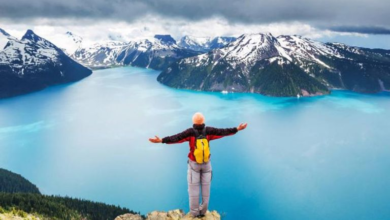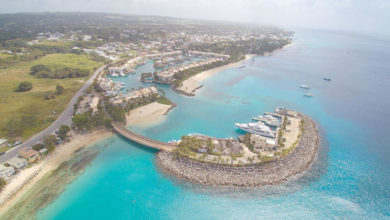Exploring the Wonders of Botswana: A Comprehensive Travel Guide

Exploring the Wonders of Botswana: A Comprehensive Travel Guide
Introduction:
Welcome to Botswana, a land of breathtaking natural beauty, abundant wildlife, and warm hospitality. Nestled in the heart of Southern Africa, this enchanting country offers a unique safari experience and diverse landscapes that will captivate every traveler. In this comprehensive travel guide, we will take you on a journey through Botswana, highlighting its top attractions, wildlife encounters, cultural experiences, and practical tips to make the most of your visit.
- The Okavango Delta:
A visit to Botswana would be incomplete without exploring the magnificent Okavango Delta. This UNESCO World Heritage Site is a vast inland delta fed by the Okavango River. Embark on a mokoro (traditional canoe) safari and glide through the tranquil waters, observing elephants, hippos, and an array of bird species. Explore the delta’s islands and floodplains, and witness the incredible wildlife that thrives in this unique ecosystem. - Chobe National Park:
Chobe National Park is a haven for wildlife enthusiasts. It is home to one of the largest concentrations of elephants in Africa, and you can witness these majestic creatures up close on a thrilling game drive or a leisurely boat cruise along the Chobe River. Keep your camera ready to capture stunning sightings of lions, giraffes, buffalos, and a myriad of bird species. - Moremi Game Reserve:
For an authentic African safari experience, head to Moremi Game Reserve in the Okavango Delta. This pristine wilderness offers diverse habitats, including grasslands, floodplains, and dense forests. Take a game drive or a guided walking safari, and encounter rare species such as African wild dogs, leopards, and cheetahs. Camping under the starry African sky is a must-do for nature enthusiasts. - Makgadikgadi Pans:
The vast expanse of the Makgadikgadi Pans is an otherworldly sight. These salt pans, stretching as far as the eye can see, transform during the wet season, attracting herds of wildebeest and zebras. Witness the surreal landscapes, go quad biking across the pans, or meet the habituated meerkat colonies for an unforgettable wildlife encounter. - Cultural Experiences:
Immerse yourself in the rich cultural heritage of Botswana by visiting local communities and interacting with the friendly Batswana people. Learn about their traditions, music, and dance during a visit to a traditional village. Don’t miss the opportunity to purchase beautifully crafted handicrafts and jewelry, showcasing the country’s artistic talent. - Practical Tips:
a. Best Time to Visit: The dry winter months from May to October are ideal for wildlife viewing, as animals gather around water sources. However, the wet season from November to April offers lush landscapes and excellent birdwatching opportunities.
b. Visa Requirements: Check the visa requirements for your country before traveling to Botswana.
c. Health and Safety: Consult your doctor for necessary vaccinations and take precautions against malaria. Observe wildlife from a safe distance and follow the guidance of experienced guides.
d. Transportation: Domestic flights, guided safaris, and self-drive options are available for exploring the country. Plan your itinerary accordingly.
Botswana offers a combination of breathtaking landscapes, abundant wildlife, rich cultural experiences, and a commitment to conservation. Whether you’re exploring the vast desert, encountering wildlife in national parks, engaging with local communities, or supporting sustainable tourism initiatives, Botswana provides a memorable and meaningful travel experience.

- The Central Kalahari Game Reserve:
The Central Kalahari Game Reserve is the largest game reserve in Botswana and one of the largest in the world. This vast expanse of wilderness offers a unique safari experience, with sightings of elusive wildlife such as black-maned lions, cheetahs, and brown hyenas. Explore the striking landscapes, including sand dunes, grassy plains, and ancient riverbeds, and witness the traditional lifestyle of the San Bushmen, the indigenous people of the Kalahari. - Nxai Pan National Park:
Nxai Pan National Park is renowned for its shimmering salt pans, which are a stark contrast to the surrounding grasslands. During the wet season, the pans transform into a lush habitat attracting large herds of zebras and wildebeest. The park is also home to an array of wildlife, including lions, elephants, and giraffes. Visit the famous Baines’ Baobabs, a cluster of ancient baobab trees, and capture the perfect sunset photograph. - Tuli Block:
Located in the easternmost corner of Botswana, the Tuli Block is a diverse and picturesque region. It is characterized by rocky outcrops, riverine forests, and open plains. Discover the Mashatu Game Reserve, where you can embark on game drives, walking safaris, and horseback safaris. Encounter wildlife such as elephants, leopards, and over 350 bird species. The Tuli Block also offers historical and cultural attractions, including ancient San rock art sites. - Khama Rhino Sanctuary:
For those interested in conservation and rhino conservation efforts, a visit to the Khama Rhino Sanctuary is a must. Located in eastern Botswana, this community-based reserve provides a safe haven for both black and white rhinos. Take a guided game drive or a walking safari to spot these magnificent creatures and learn about the conservation initiatives aimed at protecting them. - Okavango Delta Mokoro Excursions:
Immerse yourself in the tranquility of the Okavango Delta by embarking on a mokoro excursion. These traditional dugout canoes are guided by experienced polers, who skillfully navigate through the waterways, offering a unique and peaceful way to explore the delta’s intricate channels and lagoons. Witness the rich birdlife, spot aquatic animals, and soak in the serenity of this remarkable ecosystem. - Makgadikgadi Salt Pans Migration:
During the wet season, the Makgadikgadi Salt Pans come alive with one of Africa’s most impressive zebra migrations. Thousands of zebras and other herbivores traverse the vast salt pans in search of fresh grazing grounds. Witness this natural phenomenon, where the shimmering white landscape becomes a sea of animals, providing a truly unforgettable experience. - Practical Tips:
a. Accommodation: Botswana offers a range of accommodation options, from luxury lodges and tented camps to budget-friendly guesthouses and campsites. It is advisable to book in advance, especially during the peak safari season.
b. Safari Etiquette: When on safari, respect the wildlife and adhere to the instructions of experienced guides. Keep a safe distance, do not feed the animals, and follow eco-friendly practices.
c. Weather and Clothing: Botswana has a dry climate with hot summers and cool winters. Pack lightweight, breathable clothing, a hat, sunscreen, and insect repellent. Layering is recommended for cooler mornings and evenings.
d. Traveling Safely: Take necessary precautions for personal safety and health. It is advisable to have travel insurance that covers medical emergencies and familiarize yourself with local customs and regulations.
Botswana’s pristine wilderness, diverse ecosystems, and remarkable wildlife encounters make it a destination like no other. Whether you’re exploring the vast salt pans, marveling at the Okavango Delta, or encountering rare species in the game reserves, Botswana promises an unforgettable adventure in the heart of Africa.

- Okavango Delta: The Okavango Delta is a true natural wonder and one of the main highlights of Botswana. It is the largest inland delta in the world and a UNESCO World Heritage Site. The delta is formed by the Okavango River, which flows into the Kalahari Desert, creating a unique ecosystem of channels, lagoons, and islands. Explore the delta on a guided mokoro (dugout canoe) excursion, where you can glide through the waterways, spotting wildlife and enjoying the serenity of the surroundings. Take a walking safari or a game drive to see elephants, hippos, crocodiles, and a variety of bird species.
- Moremi Game Reserve: Moremi Game Reserve is situated within the Okavango Delta and offers excellent wildlife viewing opportunities. It is known for its diverse habitats, including floodplains, savannahs, and woodlands, which attract a wide range of animals. Embark on a game drive or a bush walk accompanied by experienced guides, and have the chance to spot lions, leopards, cheetahs, wild dogs, and numerous other species. The reserve also offers birdwatching enthusiasts a chance to observe a variety of resident and migratory bird species.
- Central Kalahari Game Reserve: The Central Kalahari Game Reserve is a vast and remote wilderness area, known for its stark beauty and unique wildlife. It is the second-largest game reserve in the world and home to a variety of desert-adapted species such as the Kalahari lion, brown hyena, and meerkats. Experience the solitude and tranquility of the desert landscape as you explore the reserve on game drives, guided walks, or by camping under the starry night sky.
- Makgadikgadi Pans National Park: The Makgadikgadi Pans National Park is a surreal and dramatic landscape in northeastern Botswana. These ancient salt pans, remnants of an enormous lake that once covered the area, create a vast expanse of shimmering white during the dry season. Witness the breathtaking scenery and encounter unique wildlife, including the meerkats that inhabit the area. The pans also provide the setting for the annual zebra migration, where thousands of zebras move through the park in search of fresh grazing.
- Kgalagadi Transfrontier Park: The Kgalagadi Transfrontier Park is a cross-border conservation area shared between Botswana and South Africa. It is renowned for its red sand dunes, open grasslands, and desert-adapted wildlife. The park is particularly famous for its predator sightings, including lions, cheetahs, and leopards. Enjoy self-drive safaris, guided game drives, or stay at one of the park’s remote wilderness camps to immerse yourself in this rugged and captivating environment.
- Cultural Experiences: Botswana is also rich in cultural experiences. Visit the San Bushmen communities and learn about their ancient traditions, hunting techniques, and rock art. Explore the vibrant capital city of Gaborone, where you can visit the National Museum and Art Gallery, showcasing the country’s cultural heritage. Engage with local communities, attend traditional music and dance performances, and savor the local cuisine to get a taste of Botswana’s cultural diversity.
- Practical Tips:
a. Best Time to Visit: The dry winter months from May to October are popular for wildlife viewing, with mild temperatures and less vegetation. The wetter summer months from November to April offer lush landscapes and are ideal for birdwatching.
b. Safari Lodges and Camps: Botswana offers a range of accommodation options, from luxury lodges to tented camps and self-catering facilities. It is advisable to book in advance, especially during the peak travel season.
c. Wildlife Safety: When encountering wildlife, maintain a safe distance and follow the instructions of guides. Respect the animals’ habitat and behavior to ensure both your safety and their well-being.
d. Traveling Responsibly: Botswana has a strong commitment to conservation and responsible tourism. Respect the environment, follow designated tracks, and adhere to park rules and regulations. Minimize your ecological footprint by using eco-friendly practices, such as avoiding single-use plastics.
Botswana’s untouched wilderness, rich biodiversity, and warm hospitality make it an extraordinary destination for nature lovers and adventure enthusiasts. Whether you’re exploring the waterways of the Okavango Delta, witnessing the vastness of the Kalahari Desert, or immersing yourself in the local culture, Botswana offers a truly unforgettable travel experience.

- Chobe National Park: Chobe National Park is one of Botswana’s premier wildlife destinations. It is located in the northeastern part of the country and is famous for its large elephant population. Embark on a boat safari along the Chobe River to witness herds of elephants, buffalos, and other wildlife gathering along the riverbanks. The park is also home to a variety of predators, including lions, leopards, and hyenas. Take a game drive or a guided walking safari to explore the park’s diverse ecosystems and spot a wide range of animal and bird species.
- Tsodilo Hills: Tsodilo Hills is a sacred site and UNESCO World Heritage Site in northwestern Botswana. It is known for its impressive rock art, with over 4,500 paintings dating back thousands of years. The hills hold great spiritual significance to the San people and are considered a place of cultural and historical importance. Explore the area on guided tours and learn about the stories and symbolism depicted in the rock art.
- Gaborone: Gaborone is the capital and largest city of Botswana. It is a vibrant and modern city with a mix of modern architecture and traditional African influences. Explore the National Museum and Art Gallery, which showcases the country’s history, culture, and contemporary art. Visit the Gaborone Game Reserve, located on the outskirts of the city, to see wildlife such as zebras, giraffes, and various bird species. The city also offers shopping malls, markets, and a range of dining options.
- Tswapong Hills: The Tswapong Hills are a scenic mountain range located in eastern Botswana. The hills offer opportunities for hiking, rock climbing, and exploring natural rock formations. Discover hidden caves, beautiful waterfalls, and enjoy panoramic views of the surrounding landscapes. The area is also known for its spiritual significance and is considered a place of healing and rejuvenation.
- Linyanti Marshes: The Linyanti Marshes are located in the northern part of Botswana, bordering Namibia. This pristine wilderness area is characterized by expansive wetlands, river channels, and woodlands. It is home to a diverse range of wildlife, including elephants, hippos, crocodiles, and a variety of bird species. Experience game drives, boat safaris, and walking safaris in this remote and untouched region, and enjoy the exclusivity and tranquility it offers.
- Botswana’s People and Culture: Botswana is home to various ethnic groups, with the Tswana people being the largest. The country has a rich cultural heritage, which is celebrated through traditional music, dance, and festivals. The Setswana language is widely spoken, although English is also an official language. Explore local villages and interact with the friendly locals to learn about their customs, traditions, and way of life.
- Adventure Activities: In addition to wildlife encounters, Botswana offers adventure activities for thrill-seekers. Experience adrenaline-pumping activities such as quad biking in the Makgadikgadi Pans, kayaking along the Okavango Delta’s waterways, or taking a scenic flight over the vast landscapes to gain a unique perspective of the country’s natural wonders.
Botswana’s diverse landscapes, abundant wildlife, and rich cultural heritage make it an extraordinary destination. Whether you’re exploring the national parks, delving into the country’s history and art, or engaging with local communities, Botswana offers a blend of adventure, culture, and natural beauty that will leave a lasting impression on any traveler.

- Community-Based Tourism: Botswana is known for its commitment to community-based tourism, which focuses on involving local communities in the tourism industry and sharing its benefits with them. Many lodges and camps in Botswana are community-owned, providing employment and income opportunities for local residents. Through community-based tourism initiatives, visitors can engage with local communities, learn about their traditions and way of life, and support their sustainable development.
- Kalahari Desert: The Kalahari Desert covers a large part of Botswana, extending into neighboring countries as well. It is a semi-arid region characterized by vast expanses of red sand dunes, grasslands, and sparse vegetation. The desert is home to unique wildlife species such as the Kalahari lion, desert-adapted antelope, meerkats, and the elusive brown hyena. Experience the solitude and tranquility of the desert as you go on guided nature walks or explore the area on guided 4×4 safaris.
- Makgadikgadi Salt Pans: The Makgadikgadi Salt Pans are one of the most extraordinary natural features in Botswana. These vast salt flats are remnants of an ancient lake that once covered the area. During the dry season, the pans expand and create a surreal landscape of white, cracked earth. However, during the wet season, they transform into a shallow lake attracting thousands of flamingos and other bird species. Explore the pans on guided quad biking or walking safaris, and witness the unique beauty of this otherworldly environment.
- Tuli Block: The Tuli Block is a narrow strip of land in eastern Botswana, bordered by Zimbabwe and South Africa. It is known for its diverse wildlife, including elephants, lions, leopards, and a variety of bird species. The Tuli Block offers a mix of habitats, including riverine forests, open grasslands, and sandstone ridges. Experience guided game drives, horseback safaris, or walking safaris to explore this lesser-known but captivating region.
- Khama Rhino Sanctuary: The Khama Rhino Sanctuary is a community-based wildlife project located in central Botswana. It was established to protect the endangered white and black rhinoceros populations. The sanctuary offers visitors the opportunity to see these magnificent creatures up close and learn about rhino conservation efforts. Explore the reserve on guided game drives, bush walks, or self-drive safaris and spot not only rhinos but also other wildlife such as giraffes, zebras, and various antelope species.
- Delta Duma Cultural Village: The Delta Duma Cultural Village is a community tourism initiative located near the Okavango Delta. It provides visitors with a unique opportunity to immerse themselves in the local culture and learn about the traditions and lifestyle of the Bayei people. Experience traditional dances, learn about fishing and traditional crafts, and even participate in mokoro (dugout canoe) excursions guided by local villagers.
- Conservation Efforts: Botswana has a strong commitment to environmental conservation. The country is known for its low-impact, high-value tourism approach, which aims to protect the delicate ecosystems and minimize the environmental footprint of tourism activities. Botswana has implemented strict anti-poaching measures and sustainable wildlife management practices to preserve its diverse flora and fauna.
Conclusion:
Botswana’s untouched wilderness, awe-inspiring landscapes, and abundant wildlife make it a dream destination for nature lovers and adventure seekers. Whether you choose to embark on a safari through the Okavango Delta, witness the spectacle of the Makgadikgadi Pans, or immerse yourself in the vibrant culture, Botswana promises an unforgettable journey. Embrace the magic of this remarkable country, where the wild reigns supreme and every moment is a precious encounter with nature’s wonders.



